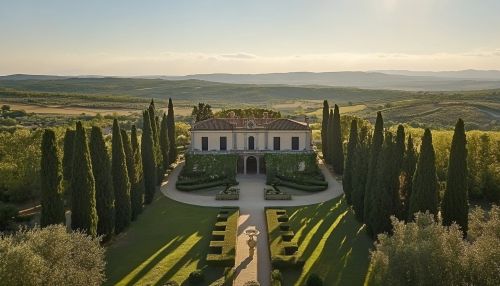Villa Rotonda: Difference between revisions
(Created page with "== Introduction == The Villa Rotonda, also known as Villa Almerico-Capra, is an iconic example of Renaissance architecture located near Vicenza, Italy. Designed by the renowned architect Andrea Palladio, the villa is celebrated for its symmetrical design and classical inspiration. It stands as a testament to Palladio's architectural philosophy, which emphasized harmony, proportion, and the integration of architecture with its natural surroundings. == Historical Con...") |
No edit summary |
||
| Line 17: | Line 17: | ||
Palladio's design philosophy also emphasized the integration of architecture with its natural surroundings. The Villa Rotonda is situated on a hilltop, offering panoramic views of the surrounding countryside. Each portico opens onto a different vista, creating a seamless connection between the interior spaces and the landscape. This approach was innovative for its time and has influenced countless architects in the centuries since. | Palladio's design philosophy also emphasized the integration of architecture with its natural surroundings. The Villa Rotonda is situated on a hilltop, offering panoramic views of the surrounding countryside. Each portico opens onto a different vista, creating a seamless connection between the interior spaces and the landscape. This approach was innovative for its time and has influenced countless architects in the centuries since. | ||
[[Image:Detail-98391.jpg|thumb|center|View of Villa Rotonda with its symmetrical design and surrounding landscape.|class=only_on_mobile]] | |||
[[Image:Detail-98392.jpg|thumb|center|View of Villa Rotonda with its symmetrical design and surrounding landscape.|class=only_on_desktop]] | |||
=== Interior Layout === | === Interior Layout === | ||
Latest revision as of 10:46, 11 October 2024
Introduction
The Villa Rotonda, also known as Villa Almerico-Capra, is an iconic example of Renaissance architecture located near Vicenza, Italy. Designed by the renowned architect Andrea Palladio, the villa is celebrated for its symmetrical design and classical inspiration. It stands as a testament to Palladio's architectural philosophy, which emphasized harmony, proportion, and the integration of architecture with its natural surroundings.
Historical Context
The Villa Rotonda was commissioned by Paolo Almerico, a retired Vatican priest, in the late 16th century. The villa's construction began in 1567 and was completed in 1591, after Palladio's death, by Vincenzo Scamozzi, another prominent architect of the time. The villa's design was heavily influenced by ancient Roman architecture, particularly the Pantheon in Rome, which is evident in its central dome and portico.
Architectural Design
Symmetry and Proportion
The Villa Rotonda is renowned for its perfect symmetry and harmonious proportions. The building is square in plan, with each of its four facades featuring a portico with six Ionic columns. The central hall is circular, topped by a dome, creating a striking visual balance. This design reflects Palladio's belief in the importance of symmetry and proportion, principles he derived from his studies of classical architecture.
Integration with the Landscape
Palladio's design philosophy also emphasized the integration of architecture with its natural surroundings. The Villa Rotonda is situated on a hilltop, offering panoramic views of the surrounding countryside. Each portico opens onto a different vista, creating a seamless connection between the interior spaces and the landscape. This approach was innovative for its time and has influenced countless architects in the centuries since.


Interior Layout
The interior of the Villa Rotonda is organized around the central circular hall, which serves as the focal point of the design. The hall is surrounded by a series of rooms, each of which is symmetrically arranged around the central axis. The interior spaces are richly decorated with frescoes and stucco work, reflecting the opulence of the Renaissance period.
Influence and Legacy
The Villa Rotonda has had a profound impact on the development of Western architecture. Its design has been emulated in numerous buildings around the world, including the United States Capitol and the Chiswick House in London. Palladio's work, including the Villa Rotonda, laid the foundation for the Palladian style, which became a dominant architectural style in Europe and America during the 17th and 18th centuries.
Palladianism
Palladianism, the architectural style inspired by Palladio's work, is characterized by its emphasis on symmetry, classical forms, and the use of columns and porticos. The Villa Rotonda is a quintessential example of this style, and its influence can be seen in countless buildings, from grand country houses to public edifices.
Modern Interpretations
In contemporary architecture, the principles embodied in the Villa Rotonda continue to inspire architects seeking to create harmonious and balanced designs. The villa's integration with its natural surroundings and its emphasis on proportion remain relevant in discussions about sustainable and context-sensitive architecture.
Preservation and Tourism
The Villa Rotonda is a UNESCO World Heritage Site, recognized for its cultural and historical significance. It is open to the public, attracting visitors from around the world who come to admire its architectural beauty and historical importance. Efforts to preserve the villa have ensured that it remains a vital part of Italy's cultural heritage.
